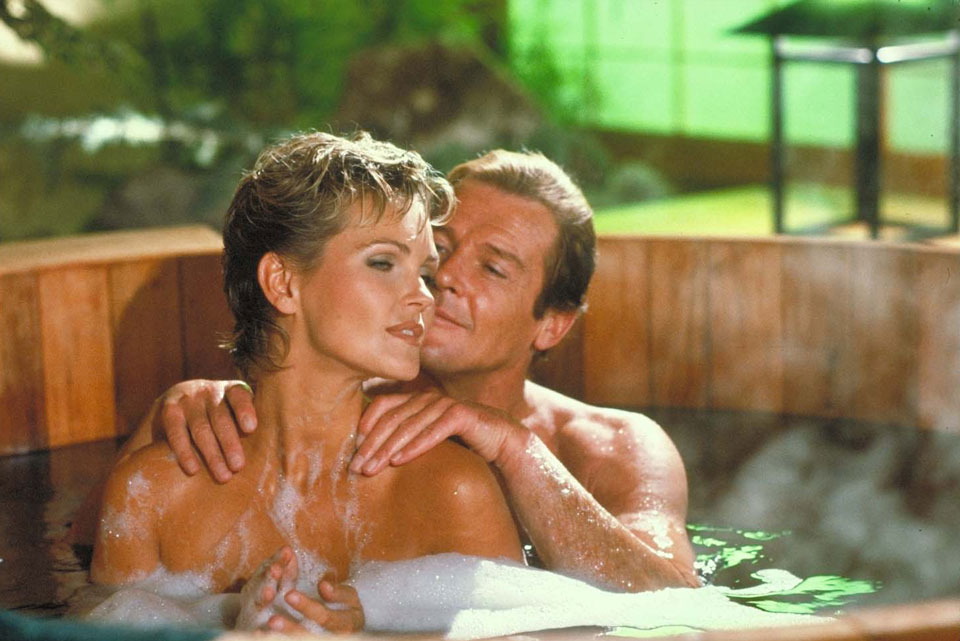
by 007hertzrumble | Oct 22, 2013 | My Favorite #Bond_age_
Mute Button Optional: The Redemption of AVTAK
by John Gilpatrick (@johnlgilpatrick)

It was 2004; I’d just started my first ever part-time job.
At the ripe young age of 14, I wasn’t exactly a saver, so each paycheck—as meager as it was for a busboy like myself—was gone before the next one arrived. The target of my retail affection? Movies. And not just any movies, but James Bond VHS tapes (yep) that I could pick up on the cheap. I didn’t know much about each movie before I bought it. All I knew was that 007 and I clicked (I credit the Goldeneye N64 video game as much as any movie). So purchases were informed by packaging more than anything else, and the phenomenal purple pastels of that A View to a Kill box just sang to me. I went home, I watched it, and… well, I didn’t love it. Far from it, actually. It was hokey. Roger Moore looked laughably uninterested. Tanya Roberts and her throaty scream—let’s just not even get into that yet. The whole exercise was borderline excruciating, and I was teenager whose idea of movie criticism was labeling something “awesome” or “not awesome.” “But wait, John, aren’t you supposed to be writing about how you love A View to a Kill? How it’s your favorite Bond movie?” Spoiler alert: it’s not. But don’t worry, I’ll get to all the things I love about A View to a Kill—and there are a lot—shortly.
*****
I collected every Bond film I could find on VHS.
(Then I bought all the DVDs. And now I own Bond 50 on Blu-Ray… yes, I have a problem.) They sat on my shelf in descending order of preference—From Russia With Love always first, Octopussy always last. Somewhere in the middle sat—side by side—License to Kill and Die Another Day, two perfectly respectable if unremarkable Bond movies, said 14-year-old me. I bring this up to demonstrate how one’s opinion of these movies changes over time and how multiple viewings can make what seems not so awesome feel kind of awesome, and vice versa. Today, License to Kill and Die Another Day could hardly be further apart on my ranked list of Bond films. And as for A View to a Kill, the hokiness that drove me crazy as a teen feels like a rather brilliant tongue-in-cheek nod to the series’s history. Roger Moore’s work as old-man Bond is so brazenly unapologetic that I can’t help but admire what he does here. And Tanya Roberts… yeah, she’s awful. That scream—like nails on a chalkboard. But still, the movie’s good qualities (and my remote’s mute button) make her contributions (or, more appropriately, her lack thereof) easy enough to abide.
*****
Time to talk about the movie, I suppose.
Following Moore’s final gun barrel sequence, we’re taken to snowy Siberia. A screechy 80’s electric guitar riffs as Moore’s 007 skis around looking for something. What exactly? A chip, hidden in a locket that’s clasped around the neck of a dead body. But wait—the Russians are coming! The Russians are coming! The ensuing ski chase is surprisingly inspired (perhaps the perfect descriptor for the film as a whole). It’s playful, with composer John Barry letting loose a little Beach Boys as Bond switches from skis to a makeshift snowboard and “surfs” across a pool of water. Before long, he’s safe in the confines of a killer gadget—a submarine-type vessel disguised as an iceberg. “Be a dear and put it on autopilot,” he tells some chick we’ll never see again before we cut to an all-time great opening credits sequence.
*****It was 1985, and the last time a relevant artist tackled a James Bond theme was eight years earlier when Carly Simon belted out “Nobody Does It Better” over the opening credits of The Spy Who Loved Me. And a male vocalist hadn’t led a James Bond theme since Paul McCartney earned an Oscar nomination for the Live and Let Die title track. I bring this up to demonstrate how against-the-grain Duran Duran’s “A View to a Kill” really is within the canon. It’s the kind of song that you’d think is ushering in a brand new Bond era, rather than closing one out. Nevertheless, it’s bold and doesn’t make a ton of sense (I’m not sure why anyone would want to dance into a fire), but with high-haired women wearing nothing but strategically placed ribbons—women who also happen to be skiing indoors and bathed in neon light—rocking out on the screen, I’m happy to rock out, too.
*****Back at MI6, Moneypenny (Lois Maxwell, in her Bond movie swan song) is dressed to the nines. M and Q give Bond a rundown of what he exactly he found in Siberia. The computer chip is designed to be impervious to an electromagnetic pulse, and it comes from Zorin Industries. Its founder, Max Zorin (Christopher Walken), is big in the horse racing circles, so it’s off to the races for our heroes. Zorin, flanked as always by the beautiful and powerful May Day (Grace Jones), owns Pegasus, who wins the race following an almost impossible to believe final sprint to the finish. It’s Bond who suspects Zorin of dirty deeds—from drugging his horse to producing counterfeit microchips—from the outset, but it isn’t until he spends a weekend at Zorin’s stables that he becomes certain.
*****
I’ll argue here that A View to a Kill doesn’t have a truly weak scene.
It’s slower sequences are always offset by delightfully brash humor; its less successful comedic moments are always overshadowed by a pretty killer action scene. That said, the film’s reputation suffers some, I think, because most watch A View to a Kill without noticing its standout scene. Bond and his partner Tibbett (Patrick Macnee) spying around the stables is not just A View to a Kill‘s best sequence (and it’s a long one, clocking in around 30 minutes), but one of my favorites in the entire Bond film catalog. Why? 1.) Solid action—the horse race—that’s unique among the Bond films. 2.) Laugh-out-loud comedy. The only thing more biting than Bond’s awful treatment of Tibbett (who’s posing as his manservant) is the smarmy way he corrects everyone who mispronounces his cover name—James St. John Smythe (that’s “sin-jin-smythe”). 3.) The insane cast of characters is confined to one relatively small space. There’s Bond, Tibbett, and Zorin (who’s a top-five villain as far as I’m concerned). May Day is this totally bizarre anomaly within the series. She’s one of the most physically imposing henchpeople Bond has or ever will come across. She’s also, I guess, a sexual presence. She and Bond share a truly weird night in bed, and she wrestles in a thong with her boss/lover, Zorin. Don’t forget, too, about Stacey Sutton (the aforementioned Tanya Roberts), who plays a much bigger role when the film moves to San Francisco. And I’ll always have a place in my heart for Scarpine (Patrick Bauchau) and Dr. Carl Mortner (Willoughby Gray)—two Zorin associates who ultimately go down in a pitch-perfect blaze of incompetence.
*****
Following the horse race, there isn’t a ton left to report.
Zorin’s grand plan, as you probably know, is more-than-vaguely reminiscent of Goldfinger‘s Operation Grand Slam. Bond and Sutton become close in San Francisco. There’s a fire at City Hall, a flood in a mine, and a fight atop the Golden Gate Bridge. It’s all pretty good stuff if you can handle Roberts spewing geology at you. (Silver lining: at least she’s not Dr. Christmas Jones.) A View to a Kill is Roger Moore’s final Bond film, and most fans wish he went out a film or two earlier. He’s lost a step, I agree, and watching him bed a woman nearly 30 years his junior is a tad uncomfortable. But it’s for all these reasons that I genuinely enjoy A View to a Kill. Everything about it feels a bit off, but it goes for the jugular on every front—Moore, Walken, Jones, Roberts, the Eiffel Tower leap, the firetruck chase, JAMES FREAKING ST. JOHN SMYTHE—and I can’t help but eat it up.

by 007hertzrumble | Oct 21, 2013 | My Favorite #Bond_age_
Octopussy: A Sweet Distraction for an Hour or Two
by Adam Slusar (@TapwaterAlice)
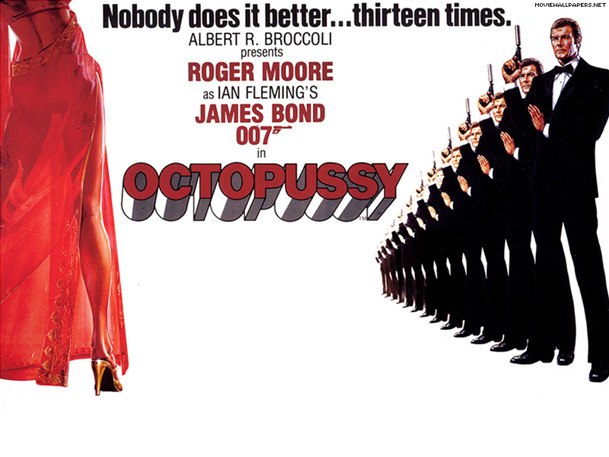
Frequently lambasted for its cartoonish excesses, perplexing storyline and – of course – being the only James Bond film to see Roger Moore disguise himself as a clown, Octopussy is generally considered to be one of the weakest entries in the 007 franchise. Like Moonraker, the humor falls flat at times; look no further than one scene in which a Tarzan cry accompanies Bond as he swings across treetop vines. Ten years after his initial turn in Live and Let Die, Moore was ostensibly “too old” to play Bond any longer. And with the revered Sean Connery set to return as 007 in Never Say Never Again that same year, Octopussy was thrown into a “Battle of the Bonds.” The odds seemed stacked against it; film critics already knew which James Bond they preferred, and needless to say, it wasn’t Roger Moore.
But while Octopussy may falter due to its occasional missteps and oddities, it’s actually pretty great. A charming, elegant, and inventive action thriller, Octopussy is superior to Never Say Never Again in almost every way, and is by far the most unfairly maligned of the James Bond films.
While the previous effort, For Your Eyes Only, was a departure from the campier Bonds of the 1970’s, Octopussy retains a comfortable balance between fanciful escapism and Fleming-esque adventure. Richard Maibaum and Michael G. Wilson, in collaboration with George MacDonald Fraser, wrote a film that fits Roger Moore like a glove; combining his penchant for casual wit with his occasional ruthlessness (as evidenced by his car-kicking performance in For Your Eyes Only). We get to see Moore deal a few bullets in addition to his fair share of one-liners.
Even with age, Moore still proves perfectly capable of selling his unique brand of 007 in Octopussy, lending a sense of credibility without betraying the overall tone of the film. His performance acts as a nice counterpoint to his passive-aggressive portrayal in Moonraker. Although the vehemently detested “clown scene” is remembered for all the wrong reasons, it demonstrates Moore in an authentic, all-too-rare occurrence of Bond losing his cool as a doomsday machine counts down to its final seconds; much like The Spy Who Loved Me or For Your Eyes Only, this showcases Moore at his absolute finest.
In terms of progressive feminism and gender equality, Octopussy is a considerable milestone in a franchise made popular by its womanizing secret agent protagonist. Leading the charge – and an army of jumpsuit-wearing female acrobats – is Octopussy herself, a neutral entity working alongside the nefarious Kamal Khan (Louis Jourdan) in a grand-scale jewel smuggling plot. Previously seen as Andrea Anders in The Man with the Golden Gun, Maud Adams lends an air of mystery, assertiveness, and professionalism to role of Octopussy. Odd though it may be for a suggestively-named Bond girl to live on an island inhabited only by women while also running a travelling circus, these sort of extravagancies are part-and-parcel with the 007 franchise, and Octopussy exemplifies the standard of proactive female characters in the Bond films.
Octopussy marks the first (but not the last) Bond film to divide its screen-time between two main villains. In addition to Kamal Khan, we have General Orlov (Steven Berkhoff), the true mastermind behind the theft of a Fabergé egg and an evil plot to overtake Western Europe with a Russian artillery brigade. This is a brilliant plot perpetrated by two sub-standard villains, but Jourdan and Berkhoff do admirably with their otherwise thinly-written roles; Khan is given juicy dialogue to complement his incredibly suave demeanour, while Orlov chews up every scene with intense proclamations.
Filling in for Oddjob and Jaws this time around is the blunderbuss-wielding Gobinda, who gets to take on Bond in some of the most inspired stunt sequences in the film. In a nutshell, the villains of Octopussy leave something to be desired, but are still more colorful and entertaining than your average Blofeld regurgitation.
Clearly inspired by the high-adventure of Raiders of the Lost Ark two years prior, Octopussy contains no shortage of tremendous action scenes. This time around, we get to see Bond pilot a mini-jet while pursued by heat seeking missiles, taking on a thug with a razorblade yo-yo, leaping across train cars while evading dangerous obstacles, and even clinging for his life from the top of an airborne plane. Here, director John Glen demonstrates his strengths as an action director. He would continue to up the ante in his three subsequent efforts. Octopussy, nonetheless, contains some of the finest stunt choreography in the Bond series.
Following the post-disco instrumentals of Bill Conti in For Your Eyes Only (of which I’m admittedly a fan), John Barry returns to the Bond franchise with Octopussy, lending gravitas to the film with a sweeping, romantic score occasionally punctuated by frenetic action cues and exotic flair. His work in Octopussy would pave the way for his return in A View to a Kill and The Living Daylights, and Barry would provide those films with perhaps his greatest work.
If you aren’t a fan of the Roger Moore films leading up to it, then Octopussy may not be your cup of tea. Still, it isn’t the train-wreck that most people would have you believe. I first watched Octopussy late in the game, expecting something utterly terrible but coming away pleasantly surprised but also a little disturbed that so many people failed to see the pure joy of Bond escapism contained within. All the negativity surrounding Octopussy chalks up to needless comparisons to the Connery era and an unusual emphasis on the sillier aspects of the film. And truth be told, it is silly, but there’s just so much more to it.
First Bond Movie: Tomorrow Never Dies
Favorite Bond Actor: Roger Moore
Favorite Bond Girl: Solitaire
How I Discovered #Bond_age_: Nic Suszczyk of The GoldenEye Dossier, who invited me to participate in the Moonraker Live Tweet Session.
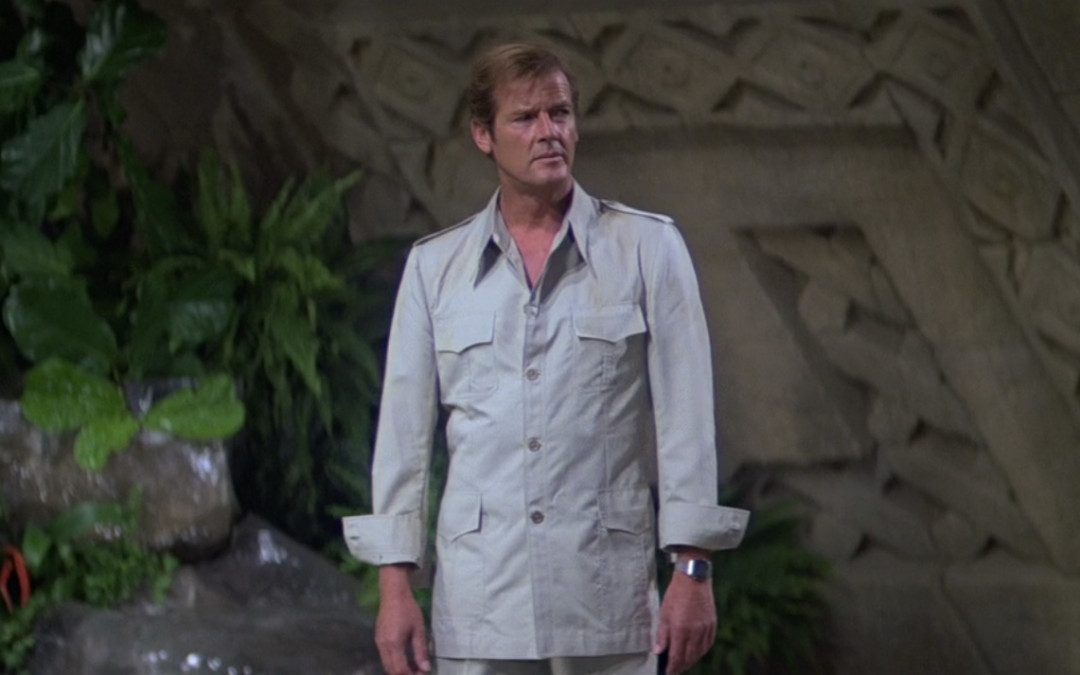
by 007hertzrumble | Oct 1, 2013 | My Favorite #Bond_age_
Moonraker: This is Not Citizen Kane
by Trevor Jost (@tpjost)

My thoughts about Moonraker (1979) can really be summed up in one sentence. Space laser battle. Which is not even really a sentence. It’s a phrase. So let’s try this to make it sound even more on point. Space. Laser. Battle. Because there’s nothing like extra punctuation to make a guy sound extra serious in a short amount of time.
But in reality there is so much more to the film then just the most incredibly awesome Space. Laser. Battle. ever put on screen. There is also a superb cable car fight scene. And if Where Eagles Dare (1968) has taught us anything, it’s that a good cable car fight scene is a must in any self-respecting action film. Often times I find myself imagining Richard Burton fighting Richard Kiel on top of a cable car… but that’s beside the point.
A good majority of the people I’ve talked to, coworkers and such, most have dismissed Moonraker as campy and looking terribly dated. While I agree to some point, it must be kept in mind that special effects man Derek Meddings, who worked on Moonraker, was nominated for the Academy award for best visual effects. I would also like to note that Moonraker eventually became the highest grossing film (raw dollars) of the James Bond series until the release of GoldenEye.
Okay… so the plot might be ludicrous, and a bunch of beliefs must be suspended but it’s a Bond film. You can’t expect Citizen Kane to spontaneously generate in a movie about a megalomaniac’s desire to create a master race by organizing the Guinness Book of World Record’s largest space orgy. Another reason that I am personally drawn to this film is Jaws. Jaws is by far my favorite Bond villain. Richard Kiel does such a wonderful job at making Jaws a terrifying and yet totally personable henchman.
Although Moonraker may not be a terribly good, it is most certainly full of thrills! (Space. Laser. Battle.) So to conclude, Moonraker is one of my favorite Bond films. If you press me I might even call it my favorite favorite. My advice is get a large bowl of popcorn, sit back, and just enjoy the ride.
Oh… and one more thing. Stop me if you’ve heard this before.
Space. Laser. Battle.
First Bond Movie: Goldfinger
Favorite Bond Actor: Sean Connery
Favorite Bond Girl: Pussy Galore
How I Discovered #Bond_age_: How did you discover me?
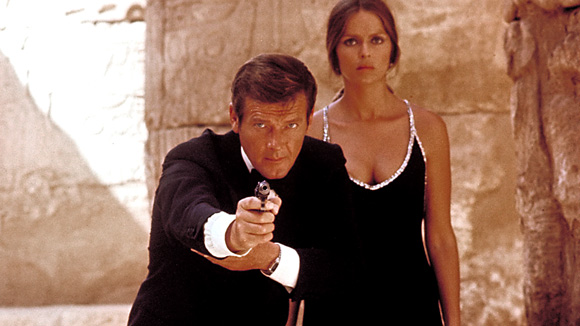
by 007hertzrumble | Sep 19, 2013 | My Favorite #Bond_age_
The Spy Who Loved Me: Bond and B-E-Y-O-N-D
by Adam Slusar (@tapwateralice)

When it comes to the Bond films, many fans would agree that the more faithful the films are to Fleming, the better they will be. And indeed, with screen adaptations like From Russia With Love, On Her Majesty’s Secret Service and Casino Royale proving to be both riveting and faithful entries to the franchise, this notion certainly has merit.
Yet we’ve also seen 007 prevail well beyond the life of his creator, adapting and transforming with each passing era.
Fleming may have envisioned James Bond as a flawed, somewhat idealized reflection of himself and former acquaintances, but cinema screens would immortalize the character in another guise; a win-at-all-costs superhero with a suave disposition and a Q-Branch trick up his sleeve. Goldfinger would exemplify this cinematic concept of Bond, building upon the source material without betraying it.
But while most of the Bonds merely took liberties with the Fleming source materials, The Spy Who Loved Me didn’t have the same luxury. Following the departure of Harry Saltzman from EoN Productions, Cubby Broccoli set out to make Spy into a feature-length film with only a title to work from (Fleming disowned the original storyline said title was attributed to). This obstacle, compounded with the dismal failure of The Man with the Golden Gun three years prior, had cynics believing that the franchise was dead in the water. (more…)
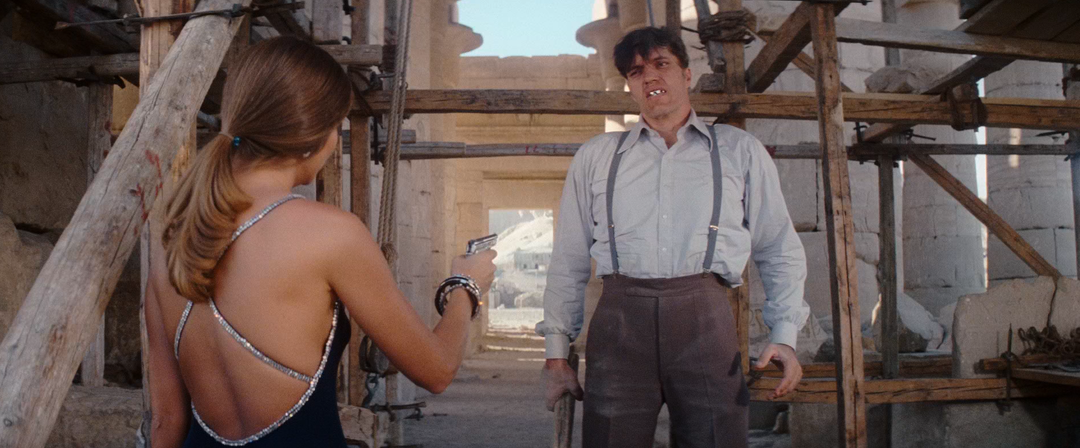
by 007hertzrumble | Sep 17, 2013 | My Favorite #Bond_age_
The Spy Who Loved Me: Reflections on the White Lotus
by Krissy Myers (@krissy_myers)

My first true experience with Agent 007 occurred at some point during the late 90’s. I was young and only vaguely familiar with the name James Bond, thanks to my mother cooing over Pierce Brosnan when he took over the role in GoldenEye. Approaching double digits in age and with TBS’s “15 Days of 007” marathon looming, my mother finally proclaimed:
“You’re old enough now. I saw my first James Bond film [Thunderball] in the theatre when I was your age. Watch some films with me.”
I trusted her completely, as by that point, she had yet to steer me wrong. After all, she was the one who introduced me to Star Wars and the Godzilla movies. By my logic at the time, if she had been treating the Bond films, for all intents and purposes, as a rite of passage, surely this English spy chap had something at least as thrilling in store for me.
I soon became engrossed in the James Bond universe. I watched as many of the films as I possibly could with school and bedtime as my only obstacles. I paid close attention to the commercials made just for the occasion featuring Bond girl Grace Jones as a flight attendant aboard a Moonraker-esque airplane. I remember making a special scheduling chart with the following sections: the name of the Bond film, the time it aired and the actor who played him. After seeing most of the films two weeks later, the inevitable question finally came up.
“You like these James Bond movies, huh, Krissy? Who’s your favourite?”
There was absolutely no question in my mind which Bond actor was my favourite. On my chart, his films would have little stars and hearts around his name to highlight his great importance. I couldn’t at the time put into words the reasons why he was my favourite, only that it was the imagery in his films that replayed the most vividly in my mind. While all of the Bond actors were undoubtedly attractive in their own ways, whenever I watched one of his films, I could physically feel the blood rush to my little schoolgirl cheeks. It was a quiet yet intense crush. (more…)

by 007hertzrumble | Sep 3, 2013 | My Favorite #Bond_age_
The Man with the Golden Gun: Francisco Scaramanga Or: How I Learned To Stop Worrying And Love The Bond
by James Longshaw (@JLongshanks7)

The Man With The Golden Gun (G. Hamilton, UK, 1974) a name that struck horror and ridicule in the hearts and minds of Bond fans for the best part of 30 years until a certain 2002 effort. It represented the end of the “Cubby” Broccoli and Harry Saltzman relationship. Indeed it was a film of lasts, as it was the title of Ian Fleming’s final book to be released posthumously. To date, it is the last to be released in the succeeding year of a previous film. But is it really that bad? Join me and discover a multitude of reasons why you should stop worrying and love this Bond.
TMWTGG begins as it intends to continue with a “House of Fun.” This house features many a trap for the unsuspecting hitman, including models, mirrors and pitfalls. What could be more fun than seeing the primary villain’s lair in all of its splendour? From this point we are already drawn in with the knowledge that our hero will be treading this same tricky path at some point in the film, especially when we see a replica of him getting a few finger tips from said villain.
It’s not long before we are treated to Lulu’s rip roaring Man with the Golden Gun title theme.
Now I’m not a massive fan of the shouting Scot but for me this theme works. It ticks all the boxes in terms of loud and proud instruments (some bold brass, shredding guitar riffs and powerful percussion) and suggestive lyrics. Kudos must go to Don Black for managing to fit such a long title into the track along with building up the mystique of the villain. From this theme we can deduce that he is wealthy (“charges a million a shot”), that he is top of his game (“an assassin second to none”) and that he derives sexual pleasure from his line of work (I’ll leave you to guess the lyric). We also have the vast array of naked female flesh on display along with multiple flashes of the titular weapon. All of this in less than three minutes is no mean feat!
We soon join our hero as he is presented with an interesting conundrum. A golden bullet with his number on it. From here on in we are thrown into the rest of the adventure much like Bond. We see everything from boat chases to flying cars and more in between. I could very easily continue with everything that is great within the narrative but I’d like to think that we are all very familiar with the story and so will break down the main reasons why I feel The Man with the Golden Gun is the best Bond film.

Another reason why I love TMWTGG is the Bond girls.
I will gladly admit that Britt Ekland as the bumbling Mary Goodnight is possibly the most hopeless Bond girl until Stacey Sutton and Christmas Jones, but like them she isn’t too bad on the eye – she worked for Peter Sellers anyway! She also plays her part in some of the more humorous exchanges including being the “butt” of a situation in the control room, having a cosy night in Bond’s wardrobe and who could forget Phuyuck?
Goodnight is complimented with the glamorous but enigmatic Andrea Anders played by Maud Adams. Again she is very pleasing on the eye (maybe it’s because I like Swedish women) but also has a major influence on the story as it is she who brings Bond and Scaramanga together. From her very first scene with Bond in which she plays part in one of the more fascinating exchanges of the Roger Moore era, she manages to bring out an aggressive streak from our hero. A rare treat indeed. I am also impressed with the chemistry that Adams has with Christopher Lee and for this she really is a girl in a million – which is ironic as that is also how much the shot cost to kill her!

The locations in The Man with the Golden Gun are yet another reason to love this film. The unforgettable “Bond Island” of Phuket plays host to most of the action in the film with its classy beach, imposing mushroom like formations and hidden alcoves. This for me is truly the pinnacle of Bond sets and the best part is that it is all natural – not a $1 million Ken Adam set in sight!
The film also displays two further memorable locations, both of which are in Hong Kong. The Dragon Garden or “grisly land” in Bond terms features a fine array of statues (some a little too lifelike) monuments and structures. We also see a fine use of a sunken ship in the Harbour – who said the bad guys always get the best lairs? All of this adds to the stunning look of the film but keeps respectful to the Bond tradition.
Now to the final reason why I feel TMWTGG is the best Bond film. He is certainly the biggest (excluding J.W. Pepper for width) and best character of the film in my opinion.
I am of course talking about the irrepressible Christopher Lee – the man who was born to play a Bond villain and play it he does in the guise of Francisco Scaramanga. From the very start of the film we see a character that dominates the screen, with an imposing frame and an air of mystery about him. Admittedly we have seen this before in the series with characters such as Tee Hee and would see it again with the likes of Jaws but these are merely henchmen; killing machines that act on orders. Scaramanga is a different beast as he works of his own free will, a brilliant example of this being the way he calculatingly disposes of his employer Hai Fat to go solo.
In every scene we see Scaramanga he oozes class. From his impeccable dress sense to his devilish sense of humour we see a character that is similar to our hero but at the same time the polar opposite. One works for “a hearty well done from her Majesty the Queen and a pittance of a pension” while the other gets a million dollars a contract. Two different lives you would say, but in the very same scene Scaramanga gets under the skin of an equally well-attired Bond by making him admit that “killing you would be a pleasure”. This makes Scaramanga a more menacing type of villain as he barely acknowledges his status even when delivering his chilling “indisputable masterpiece” speech. At least Blofeld, et al knew what they were doing was wrong and would use any means necessary to get to their aims.

The film builds up to the climactic showdown of these two expert assassins. The tension is as good as anything in the entire series with fine pacing and a few shocks up its sleeve. When Bond emerges victorious, as he so often does in these situations, he does so in a fitting manner. There is nothing of the over-inflated deaths in previous films just a plain simple shot that befits the way Scaramanga lived. Sometimes the simple ways are the best!
So what of Bond himself?
I feel Roger Moore is clearly settling in for the long haul with The Man with the Golden Gun. The ingredients are all here for a classic Moore film – fantastic villains, beautiful women, great humour and scenes that defy explanation: in this case the AMC Hornet spiral jump. To summarise, TMWTGG may not have got its “indisputable masterpiece” but it is certainly a fascinating part of the James Bond story.
First Bond Movie: At the cinema it was GoldenEye. I watched so many from a young age that I’m not entirely sure which the first Bond I saw was but I remember Goldfinger leaving a big impression on me.
Favourite Bond Actor: Roger Moore for his larger than life adversaries, brilliant humour and sheer longevity.
Favourite Bond Girl: If I’m thinking superficially and saying looks the much maligned Christmas Jones may have a chance. As it is I like the complete package so would say the “triple X” rated Anya Amasova. A fascinating Bond girl as she is a female equivalent that could kill him at any time. I’m also a sucker for a faux Russian accent!
How I Discovered #Bond_age_: I believe I was discovered through a friend. I like what I saw and the rest as they say is history.
First #Bond_age_ Live Tweet: I’m still awaiting my official debut.















